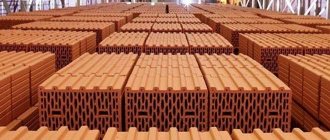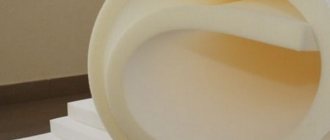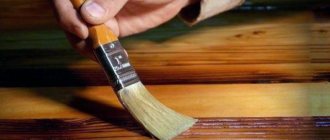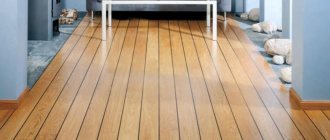Staining wood is painting a treated wood surface with stain to give it color while preserving the natural wood texture. Often painting with stain is done to decorate the surface to resemble a more expensive type of wood.
Stains are chemical compounds that do not form a film on the surface of wood. Since the stain is absorbed into the surface, it creates a beautiful wood texture. However, often the composition does not have protective properties, so painting wood with stain and varnish is carried out simultaneously.
The coloring of a surface with stain does not occur due to pigment, but due to chemical reactions. Therefore, depending on the type of wood, the same composition can “appear” in different colors. Before starting work, be sure to test the stain on an inconspicuous area of the wood.
Varieties of stains.
If you are new to woodworking and just getting started with woodworking, choose an oil stain . It takes a long time to dry, so make sure that during the drying process that dust and small debris do not get on the product, this will ruin the work. But it is the oil-based stain that makes it easy to apply an even, beautiful layer. Moreover, such a stain allows for errors.
Water-based stains.
The most common type of stain.
They must be applied carefully and evenly. Since such stains can raise wood fluff. Before processing, the wood should be wetted, sanded and, after drying well, treated with stain. Alcohol stain is difficult to apply by hand; it is sprayed onto the surface using a spray gun.
Rustic acrylic and wax stains.
New developments. Moreover, this type of coating is only conventionally called stain, since they also preserve the natural structure of the wood. This stain can be of any shade. It is easy to apply and does not raise the lint. Forms a film on the surface and has protective properties. However, like other stains, rustic stain must be varnished.
- When painting wood with stain, do not repeatedly brush over drying wood fragments. Because then the brush strokes will be visible.
- Only dry wood with a moisture content of no more than 12% can be stained.
- For a beautiful result, the stain should be applied in two or three layers. Before applying the next layer, allow the previous layer to dry completely.
Varnish for coating wooden surfaces
Varnishes that are used to coat wood come in several types:
- Alkyd.
- Polyurethane.
- Acrylic.
- Nitrovarnishes.
- Alcohol.
- Oily.
- Parquet with acid hardener.
Alkyd varnishes must be diluted with a solvent . The surface treated with this product is protected from fire and water and does not fade in the sun. Thanks to acrylic varnish, a film is formed that does not allow the wood to wear off and slows down the aging of wood.
Nitrovarnishes, although they dry much faster, however, are not able to withstand the negative effects of ultraviolet radiation and moisture for too long. Polyurethane varnishes are characterized by increased wear resistance and form a durable film on the wooden surface that dries very quickly.
Relatively recently, oil-based varnishes were very popular, but nowadays they are used most often for treating floors. Their main advantage is their low price. Such varnishes must be diluted with drying oil, and they take a very long time to dry. Such a new product as acrylic varnish, which is universal and easy to use .
It is used for both external and internal work. This varnish should be diluted with water, and it does not have a strong odor. With its protective qualities it resembles alkyd varnishes, but is much more economical to use . But alcohol varnishes are used only for the restoration of antique furniture.
Preparing the wooden surface
It is recommended to apply stain and varnish only to smooth and sanded surfaces. Regardless of whether the coating should be painted - new or old, it must be carefully inspected. All detected cracks, seams and knots should be processed and eliminated .
If gaps are also found between the joints and seams, they are sealed with special putty . As soon as it dries, to remove possible unevenness, the putty areas are sanded again using fine sandpaper.
One should take into account the fact that it makes no sense to putty on raw or under-dried wood, much less treat it with stain or varnish it. Such wood begins to deform and the applied layer always becomes unusable.
Watch a video about the features and types of stain
Different types of wood react differently with stains, especially “real” ones, i.e. coloring fibers due to chemical reactions.
Thus, a stain based on ferric chloride will give oak a black color, make apple or pear wood only a little grayish, and will not have any effect on pine at all.
Resinous and, in particular, coniferous species can behave even more unpredictably with different types of stains.
Advice. Before applying stain, test paint several samples that closely match the wood of the piece being treated.
Water-based stains often cause wood pile to rise, significantly reducing the quality of the coating. In this case, the surface of the part is pre-moistened with clean water, allowed to dry, and then sanded again, removing loose fibers.
Advantages and disadvantages
The use of stain has positive and negative properties; in order to understand whether this particular material is worth choosing, it is necessary to evaluate each aspect. The advantages of using the composition include:
- A variety of tint types that can give a wooden surface an unusual appearance;
- The grain of the wood is not lost, but rather stands out after processing the stain;
- Water-repellent coating structure;
- Antiseptics are included that protect the tree;
- Affordable cost of the composition.
But there are also disadvantages to these funds; experts note the points described below:
- There are types of stains that raise the fibers of the base, then it is necessary to sand the wood in advance to get a high-quality result without flaws;
- Not every type of stain is capable of creating a barrier from negative factors on a wooden base, and it is necessary to use other compositions;
- A number of products can only be used outside the building, and the master must wear protective gloves, a respirator and clothing;
- Some of the compositions are characterized by quick-drying properties; this requires the master to be able to cope with uniform distribution at a fast pace.
Antiseptics are turned on to protect the wood.
How to stain wood: methods and tools
Painting with stain is practically the final stage in the production of wooden products, so it can only be started after mechanical processing, incl. decorative (polishing, brushing, sharpening, etc.), completely completed.
The wood should not have any contaminants, even invisible ones (for example, grease stains); during processing they will instantly “appear.” It is not allowed to paint wood with a moisture content above 12-14%, especially those based on nitro compounds and oil.
Painting with stain with a brush
How to stain wood?
If you plan to apply a protective coating to untreated boards, it is important to evaluate the degree of drying of the material. A wet surface cannot be treated with any means. This will be of little use, and when dried, the fibers will disperse, and the resulting gaps will remain unprotected.
After quality control of the material, you need to sand the surface. This can be done with a special grinding machine or manually with sandpaper (various degrees of abrasives are used to effectively eliminate defects and achieve smoothness). If during preparation you find deep cracks or crevices, you need to cover them with putty intended for wood.
When working with wood that has been previously treated with paint or varnish, it is imperative to remove the old coating layer. This can be done with sandpaper. If removing paint or varnish is problematic, you can use a special remover or a hair dryer. The wash is easy to use; just spread it over the surface in an even layer and leave it for a while for the active ingredients to take effect (the duration of treatment is indicated on the packaging).
Making your own stain
There are a large number of folk recipes for making stain at home. Various shades of brown can be obtained by preparing a solution of ordinary potassium permanganate. It is necessary to experiment a little to achieve the desired result, selecting the concentration of the solution. The surface stained with potassium permanganate must be protected from fading, for example, with varnish.
Another simple way to stain wood is to brew strong tea. It will give the wood a rich brown tint. You can also kill a tree with strong brewed coffee. The natural brown color comes from wood treated with a rich decoction of walnut shells, crushed to a powder.
A decoction of oak bark will give the wood a black tint. The golden color is obtained by treating wood with a decoction of buckthorn fruits. A red-brown tint can be obtained by treating a wooden surface with a concentrated decoction of onion peels.
How to stain wood?
To more clearly emphasize the texture of the wood (especially after brushing), to give it an unusual color or an “antique” look, the part is coated with two different stains.
They do it this way: first, the wood is covered with a light (often bleaching) water- or alcohol-based stain, creating a general background. Then, a darker stain on an oil or oil-wax basis is applied with a swab or roller. At the same time, the denser fibers that form the pattern remain light.
White tinting for wood
There is a wide variety of wood stains, differing in color and composition. Wood will always be popular, because it is a beautiful and environmentally friendly material. However, like all natural decorative elements, boards are afraid of moisture and are a favorite habitat for insects, fungi, mold and other microorganisms.
To increase the service life of things made from wood, various protective agents and antiseptics are used.
Today we will talk about such a wonderful substance as stain, with its help you can not only solve some problems associated with premature damage to wooden materials, but also give your products an unusual and noble appearance.
What is wood stain
Wood is a strong and durable material that is susceptible to adverse environmental factors, therefore, in order to protect products made from it from possible damage, they must be treated with special means. On the construction market you can find a huge number of different antiseptics, varnishes and other impregnations that change the color and some properties of wood; the most popular and inexpensive product is stain. Some people think that stains are used only to change the color of an object, but this wonderful drug also has other properties.
The color of wood stain should be chosen depending on the interior design.
The properties of stains may vary depending on their composition. However, even if you do this tint yourself, it will still have some protective properties.
Properties of stains:
- If you want to change not only the color of the wood, but also highlight its texture, then stain is just what you need. It does not completely cover the design, like paint, but gives the entire product a pleasant shade.
- Staining wood will protect furniture from insects and rot, while maintaining the texture and grain of the wood.
- Stain is a protective agent that increases the service life of wooden objects and costs several times less than varnish and paint. In addition, due to its watery consistency, it penetrates deeper into the wood structure.
- With the help of stain, you can make even inexpensive pine, painted with colored stain, look like noble and strong oak and exotic mahogany.
- Tinting with stain can lighten the wood. This technique is especially often used before painting wooden products.
- Impregnation with stain will strengthen the structure of the wood and give it a slight moisture-proof property.
Not all stains have the above qualities. To understand what kind of stain you need, you need to read its composition and see what the instructions for use say. By the way, you can treat not only solid wooden boards with stains, but also chipboard, objects made of plywood or parquet and other wooden crafts.
Water-based wood stain and alcohol stains
Water-based stains are the most environmentally friendly stains. They do not have a strong unpleasant odor and are easy to use.
This product can be sold as a dry or ready-made mixture. Such dyes are most popular due to their low price and the possibility of their use for both interior and exterior work.
Water-based wood stain can significantly improve the appearance of wood flooring
Main characteristics of water stain:
- The colors of water-based stains are very diverse. With their help you can create a very interesting iridescent effect.
- You can use water sprays without fear for your health. Even at the highest temperatures, such products do not emit harmful fumes.
- If you decide to experiment and are wondering: “Which stain to choose so that it can be washed?” – then water stain is what you need. This tinting agent can be easily washed off with water, so painting the floor with it is impossible.
- Tinting a wooden surface with this method makes its texture more noticeable. Unfortunately, this makes the product more sensitive to moisture, so it will need to be opened with varnish.
It is extremely undesirable to tint resinous tree species with such impregnation, as unsightly stains may appear on them. For such products it is better to use alcohol impregnations.
How long does alcohol impregnation take to dry? Almost a few seconds! This property is both an advantage and a disadvantage. Thanks to it, you can cover the butt of a sporting rifle with alcohol stain, and use it in just a few minutes, however, a large area can only be stained with a spray gun, otherwise the surface of the product will become covered with unpleasant stains and stains, and even varnish will not help correct the situation. The alcohol impregnation consists of alcohol and dyes.
Source: https://vemiru.ru/info/belaja-tonirovka-dlja-dereva/
How to treat a wooden door?
Wood has a big disadvantage - it absorbs moisture. An expanded sash cannot be closed or opened normally. To prevent a wooden door from swelling from dampness, before painting it must be treated with a protective impregnation and preparatory measures must be carried out.
- The process begins with removing the sash from its hinges and dismantling the protruding fittings. The canvas is laid on a horizontal surface, sanded and thoroughly cleaned from dust.
- When using paint, the clean surface of the wooden door is impregnated with a primer. The first layer is allowed to dry and the second treatment is performed.
- The panel door is painted with a roller, and the panel door with a brush. Depending on the structure of the material, 2 to 4 layers of enamel are applied.
- If stain is used instead of paint, the surface of the wooden door is not primed. The door leaf is simply sanded and cleaned of dust. The stain itself is a protective impregnation that penetrates deeply into the wood.
A wooden entrance door needs to be treated especially well, since outdoors the door is constantly exposed to moisture and temperature changes.











